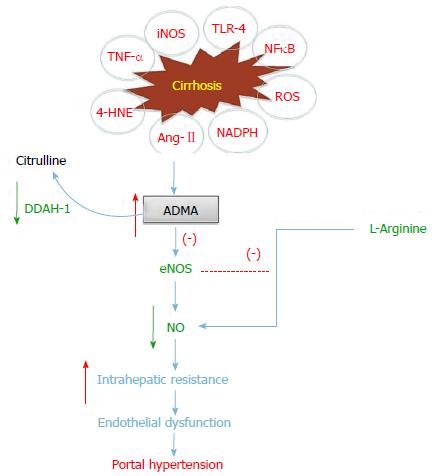Copyright
©The Author(s) 2015.
World J Hepatol. Mar 27, 2015; 7(3): 443-459
Published online Mar 27, 2015. doi: 10.4254/wjh.v7.i3.443
Published online Mar 27, 2015. doi: 10.4254/wjh.v7.i3.443
Figure 1 Schematic representation of the proposed role of inflammation and oxidative stress in mediating hepatic endothelial dysfunction in cirrhosis.
Inflammation and oxidative stress are synergistically triggers accumulation of ADMA in the systemic circulation and the liver. Increased ADMA endogenously inhibits eNOS results in decreased hepatic NO production, which causes increased intrahepatic vascular resistance and endothelial dysfunction thus, portal hypertension in the context of cirrhosis. Inflammation and oxidative stress also inhibit ADMA hydrolysing enzyme, DDAH activity and promote methylarginine concentrations in the liver. L-arginine is the source for eNOS enzyme for NO production and is vasoprotective. TNF-α: Tumor necrosis factor α; NFkB; Nuclear factor kappa B; TLR: Toll like receptor; Ang II: Angiotensin II; NO: Nitric oxide; ADMA: Asymmetric dimethylarginine; eNOS: Endothelial nitric oxide synthase; DDAH: Dimethylarginine diaminohydrolase; iNOS: Inducible nitric oxide synthase; 4-HNE: 4-hydroxy-2-nonenal; NADPH; Nicotinamide adenine dinucleotide phosphate-oxidase; ROS: Reactive oxygen species.
- Citation: Vairappan B. Endothelial dysfunction in cirrhosis: Role of inflammation and oxidative stress. World J Hepatol 2015; 7(3): 443-459
- URL: https://www.wjgnet.com/1948-5182/full/v7/i3/443.htm
- DOI: https://dx.doi.org/10.4254/wjh.v7.i3.443









